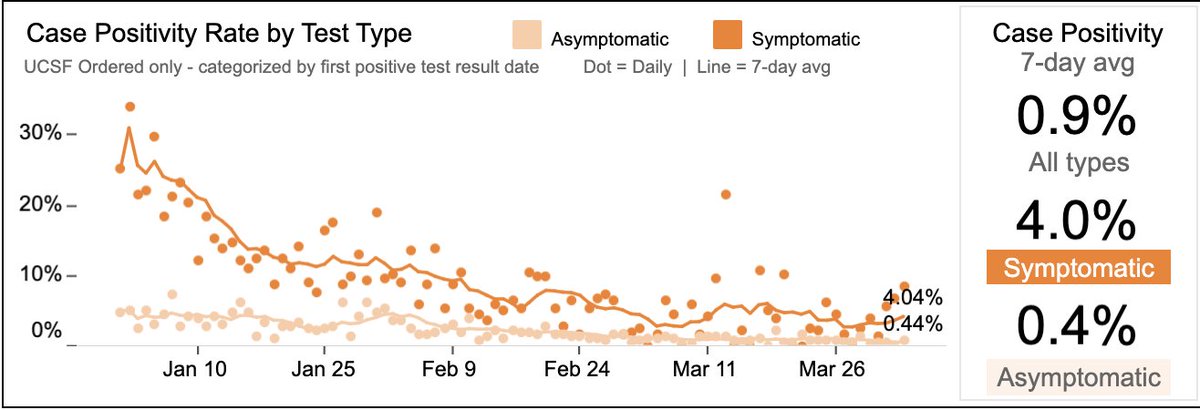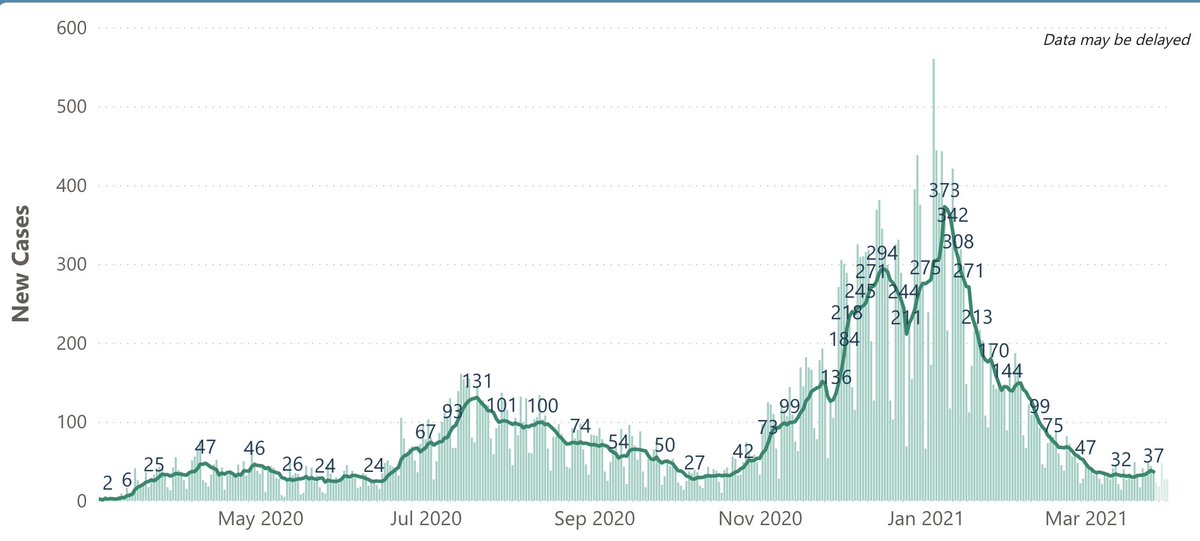1/ Covid (@UCSF) Chronicles, Day 383
Perhaps the most confusing time since the start of the pandemic – its easy to be overwhelmed. I’ll try to make sense of some of the key trends, particularly the “4th surge” & vaccines vs variants.
Bottom line: I’m still leaning optimistic.
Perhaps the most confusing time since the start of the pandemic – its easy to be overwhelmed. I’ll try to make sense of some of the key trends, particularly the “4th surge” & vaccines vs variants.
Bottom line: I’m still leaning optimistic.
2/ Part of my optimism stems from where I live: Covid stats in San Francisco are excellent. Let’s start w/ @UCSFHospitals, where there are 7 Covid pts (vs. ~100 in January), & only one on a vent (Fig L). Test positivity is 0.9%; 0.4% in asymptomatic patients (R). Pretty darn low. 



3/ SF overall is also good: 37 cases/day in city of 875K, maybe a tiny uptick in past few days (Fig L). Only 21 Covid pts in all SF hospitals (vs. 259 in January; R). And only 6 Covid deaths in SF in past 4 weeks; total deaths remain <500 for pandemic. Test positivity also 0.9%. 



4/ Why such good control in SF? It's partly behavior: most still masking; indoor dining open @ 50%. And 48% of SF adults have rec’d one shot; 27% are fully vaxxed. (U.S. avg: 31% one dose; 18% both) We have variants, but mostly West Coast one – bad, but not as bad as UK variant. 

5/ In regions w/ surges (Michigan, Northeast), it’s likely that some combo of these factors are at work: people lowering their guard, opening of high-risk settings too soon, lower vaccination rates, & higher prevalence of UK variant. Hardest hit places have more of these at play.
6/ The variants are scary but beatable – through remaining careful & by vaccination (which works well against variants currently in U.S., mostly UK's B117). Plummeting case rates in UK & Israel (Fig) offer vivid evidence that UK variant can be defeated by widespread vaccination. 

7/ Note: U.S. isn’t far behind UK in vaccine doses given – U.S. has given enough vax for 24.9% of population; UK 27.4%. Why is Covid falling faster there: a) they’ve (smartly) opened more slowly, & b) they’ve employed delayed 2nd dose strategy, having vaccinated 47% of populace…
8/ … with one shot, but only 8% with two shots. Conversely, U.S. has stuck w/ on-time 2nd dose strategy: 31% have rec'd one dose, 18% both. I still believe UK made the better call: we now know that one dose is 80% protective – so UK got more people protected faster than we did.
9/ Why am I optimistic despite our regional upticks? Because virtually all we've learned about the vaccines is phenomenal. First, we now know that their efficacy in real world settings matches that seen in clinical trials: ~90%. cdc.gov/mmwr/volumes/7… That's astoundingly good.
10/ AND we know that the earlier question – namely, does vaccination cut the risk of asymptomatic transmission? – has been answered: Yes! That's great news. sciencenews.org/article/corona….
AND we know that near-perfect vaccine protection vs. hospitalizations & death remains true in…
AND we know that near-perfect vaccine protection vs. hospitalizations & death remains true in…
11/ …real world settings. AND that our vaccines appear to work just fine, thank you, against the variants that we’re actually seeing in U.S. AND that our vaccination pace has skyrocketed to ~2.5-3M/day. AND that the three vaccines that we’re using in the U.S. are completely…
12/ … safe, both in terms of short-term side effects/ allergies, & long-term effects.
(Parenthetically, this piece @TheAtlantic theatlantic.com/health/archive… on AstraZeneca clotting issue is worth reading – while “blood clots” are common, the syndrome of low platelets & widespread…
(Parenthetically, this piece @TheAtlantic theatlantic.com/health/archive… on AstraZeneca clotting issue is worth reading – while “blood clots” are common, the syndrome of low platelets & widespread…
13/ …clotting is not, so I’d guess that this is in fact a rare side effect of AZ vaccine. The benefits of getting vaccinated still far outweigh this tiny risk, but it's a nail in the coffin for AZ’s efforts to be part of the U.S. arsenal, since we’ll have enough vax without it.)
14/ AND finally, we’re seeing rising numbers of people who want to be vaccinated pewresearch.org/science/2021/0… ; no longer big differences between whites & communities of color. Now it seems that it's mostly Republicans choosing to forego vaccination. The White House is rolling out…
15/ …a vigorous campaign to promote vaccination in various groups (Walensky’s “Doom” speech was likely part of it).
Once vaccination is fully/equitably available to all (in next 6-8 wks), if someone chooses to forego their shot that’s a personal choice...but it’s an awful one.
Once vaccination is fully/equitably available to all (in next 6-8 wks), if someone chooses to forego their shot that’s a personal choice...but it’s an awful one.
16/ Because here’s how I think about Covid in the U.S. today:
In 2020, we were all at risk, but some were at higher risk of getting Covid due to exposure (job or living circumstances, +/- behavior) or at higher risk of dying from Covid due to age/comorbidities/access to care.
In 2020, we were all at risk, but some were at higher risk of getting Covid due to exposure (job or living circumstances, +/- behavior) or at higher risk of dying from Covid due to age/comorbidities/access to care.
17/ While the traditional categories related to risk of exposure & death are still meaningful, today we need to divide the population into three different groups:
a) Fully vaccinated
b) Partly immune (via partial vaccination or prior infection), &
c) Unprotected.
a) Fully vaccinated
b) Partly immune (via partial vaccination or prior infection), &
c) Unprotected.
18/ Fully vaccinated folks can live pretty large, as @CDCgov has signaled in their new guidance about get-togethers & travel. Even with variants growing, the protection against getting Covid, transmitting it, & particularly against getting very sick & dying is truly impressive.
19/ Partly immune folks are safer, but they should still be careful. Even if you’re ~80% protected via your first mRNA shot or via prior infection (Denmark study: ~80% protection from prior infection, but only ~50% in those >65 thelancet.com/journals/lance…), the variants are so much…
20/ …nastier (B117: ~60% more infectious & ~60% deadlier) that their risk is still very real.
For these folks: finish vaccination as soon as you can; it still seems likely that those w/ prior infection may only need 1 shot of mRNA vax, but that’s not yet endorsed by FDA/CDC.
For these folks: finish vaccination as soon as you can; it still seems likely that those w/ prior infection may only need 1 shot of mRNA vax, but that’s not yet endorsed by FDA/CDC.
21/ (I know that some may cry hypocrisy when I recommend that partly vaccinated folks get 2nd shot ASAP, while also promoting delayed 2nd shot strategy. It’s the difference between individual vs public health. As an individual, it’s better for you to finish both shots fast, but…
22/ … as a society, we’d be better off if more people got first shots sooner. Another reason why life as a public health official is so impossibly tough.)
And finally, the third group is the unvaccinated. If anything, they're at higher risk than at any time in the pandemic…
And finally, the third group is the unvaccinated. If anything, they're at higher risk than at any time in the pandemic…
23/ …since they remain completely vulnerable to SARS-CoV2 generally & now face a variant that's even more infectious & deadly. Moreover, due to Covid fatigue and/or misguided messaging, many are acting less safely. If there’s a fourth wave, this is the group that'll be hammered.
24/ A saving grace is that, on avg, they're younger & healthier than folks who've been vaccinated. The bad news: with large numbers of infections, plenty of them will still get sick & some will die, and their infections will fuel higher rates of transmission & thus more variants.
25/ So it could go either way: a virtuous cycle if folks stay careful & get vaccinated. A vicious one if folks act unsafely or don’t get jabbed. Worst case: more vaccine-resistant variants.
Taken as a whole, I’m still optimistic. But you can see why it’s so darn confusing. /end
Taken as a whole, I’m still optimistic. But you can see why it’s so darn confusing. /end
• • •
Missing some Tweet in this thread? You can try to
force a refresh






